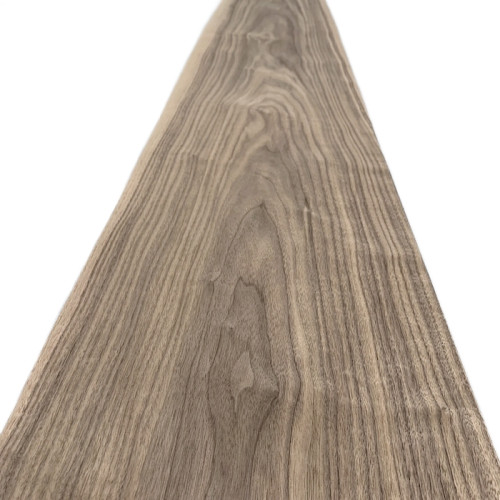
Black Walnut Crown-cut Veneers 300 x 33 cm
Black Walnut Crown-cut Veneers 300 x 33 cm
Genuine wood sliced-veneer sheets, in sequence.
Length: 300 cm.
Width: 33 cm.
Thickness: 0.52 mm.
Sold by the sheet.
These photos are taken from the veneer sheets you will receive.
Black Walnut Crown-cut Veneers 300 x 33 cm
Genuine wood sliced-veneer sheets, in sequence.
Dimensions:
Length: 300 cm.
Width: 33 cm.
Thickness: 0.52 mm.
Measurement scaling:
Dimensions are measured at the small end.
- Width rounded to the covered centimeter: 15.8, giving 15 cm.
- Length rounded to 5 centimeters: 257, giving 255 cm.
Product Description:
Genuine wood-sliced veneer sheets.
These veneers are raw without a finish or any fleece back.
The veneer surface is similar to plane wood. However, it will be preferable to forecast a light sanding after gluing.
The veneers are offered here as wood-sliced sheets of one and unique thickness.
Both faces of these veneers are the same, without fleece back or glue.
Even if the veneer's sides had been cut relatively straight, it isn't a precise parallel clipping, and some veneers may have kept the decreasing shape of the tree, wider at the bottom end and narrower at the top end.
Some veneers' sides occasionally have unclipped wane traces, but our veneers are measured at the narrowest, as explained in the paragraph dimensions.
As genuine natural wood, all finishing products are acceptable as long as they are meant for wood usage.
The choice of the finished product must be consistent with the final usage realization.
The Species:
Common Names:
American Walnut, US Walnut, and Black Walnut.
Botanical Name:
Juglans Nigra. For the record, in Latin and during antiquity, Juglans refers to the fruits of the tree: glandi and Ju for Jupiter.
Origin:
North America, Eastern United States, Eastern Canada.
However, it can also be found in Europe and in particular in France, planted in castle parks since the 15th century, where it was in good taste to have tree species from the New World.
Appearance:
This wood is appreciated for its uniformity of structure and color, fairly dark brown with fine black veins.
In its raw state (unvarnished) its color is gray with purplish reflections, which gives way to a more or less dark brown once varnished or oiled.
With the patina of time, its brown color will give way to an orange honey. However, this orange honey can be obtained by using a blond walnut (walnut sapwood) and a slightly orange-tinted finish.
It should be noted that American walnuts grown in France have a less gray and more brown color.
Properties:
Weight: 610 Kg/m3, average weight at 10-12% humidity.
Janka Hardness: 4490 Newton, for comparison: Oak is at 4980 N, and Poplar is at 1650 N.
Modulus of Elasticity: 11.59 GigaPascal, for comparison: Ash 12.31 GPa and Poplar 9.75 GPa.
Uses:
Walnut is used in furniture making, decoration, car dashboards, guitar making, and old radios.
Several specialties are particularly sought after, such as its burl, the root part of the trunk offering a very lively veining, or its burl, an outgrowth formed by hundreds of small knots.
Use of the veneers:
Cutting:
Veneers can be easily cut with a utility knife.
For straight cuts, the best results are obtained with a veneer saw.
Use a fretsaw, scalpel, or veneer knife for curved cuts.
Always allow for a slightly larger veneer sheet than your intended surface. This will allow you to adjust the size after gluing for a clean finish.
A flush trimmer can also be used to trim the veneer after gluing.
When cutting with a utility knife or veneer knife, it is best to cut with the grain of the wood. To check this, run your finger along the edge of the sheet. The direction that feels smoothest is the ideal direction for cutting.
Gluing:
Several types of gluing are possible.
With vinylic glue, the veneer is pressed over its entire surface.
With neoprene glue for all surfaces, especially non-porous surfaces, by applying two coats of glue and marouflage.
With animal glue such as hide, sinew, or bone glue.
With vinyl glue and an iron, apply two thin coats of glue to each piece. This technique should only be used if other gluing techniques are not possible.
Sanding:
Veneers and all our products are wood and can be sanded according to their thickness.
Regardless of the thickness of the veneer, do not use a belt sander, as this could pierce it.
With a 0.6 mm veneer, lightly sand with 120 grit and then finish with 180 or 240 grit. With an orbital sander, 180 grit is already sufficient for most applications.
Finishing:
All finishing products generally used for wood are suitable for finishing our products. For example, you can use a varnish, wax, paint, or oil.
However, ensure that the product you want to use is compatible with the final use of your creation.
Packing:
Veneers are rolled and well protected in a strong carton chosen to resist somewhat vigorous handling and delivered to you in good condition.
More info:
If you need more info, please look at our TUTORIALS; you might find some valuable tips.
Please contact us for any additional information by email or phone.
Data sheet
- Species
- Walnut
- Thickness group
- Standard
- Grade
- Crown-cut
 English
English




